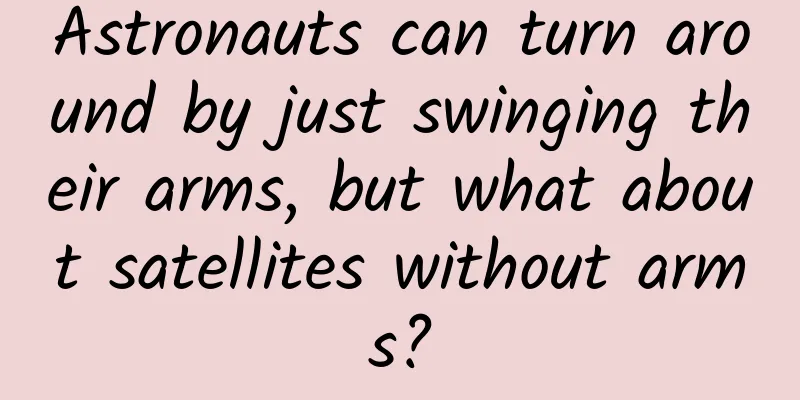Astronauts can turn around by just swinging their arms, but what about satellites without arms?

|
On December 9, 2021, "space teachers" Zhai Zhigang, Wang Yaping and Ye Guangfu gave a wonderful space science class to young people at the Chinese space station. This was the first time in 8 years that Chinese astronauts gave lectures in space. The three astronauts demonstrated experiments such as turning in space and making water balls bloom, showing us the tip of the iceberg of the astronauts' peculiar lifestyle in a microgravity environment. Space teaching live broadcast (Photo source: Xinhua News Agency B Station) Part 1 Why is it so difficult to turn in space? It's all about angular momentum Why is turning, which seems so common on the ground, so difficult to do in space? This is actually the effect of the principle of conservation of angular momentum. Angular momentum is a parameter that describes the rotation of an object. Generally speaking, the greater the mass of an object, the faster the rotation speed, and the larger the rotation radius, the greater the angular momentum. The conservation of angular momentum means that when an object rotates, if there is no external force or the total torsional effect of the external force is 0, the angular momentum remains unchanged. When a person is floating in space, with an initial angular momentum of 0 (i.e. stationary and not rotating), he cannot turn around by twisting his body without the help of any external objects. Astronaut Ye Guangfu's experiment has proved this, and we on the ground can turn around by using the ground to gain momentum. Astronaut Ye Guangfu tried to spin himself by turning his upper body during a space turning experiment, but failed. (Photo source: Xinhua News Agency B Station) There is a detail in this attempt. When Ye Guangfu tried to rotate his upper body, his lower body automatically rotated in the opposite direction. This is because when the upper body rotates, an angular momentum is generated, and the lower body automatically generates an angular momentum in the opposite direction, which offsets the angular momentum generated by the rotation of the upper body to achieve conservation. But after that, due to the limitations of the lumbar spine and waist muscles, the upper body could not continue to rotate (after all, people cannot separate the upper and lower bodies and let them rotate separately), and the attempt failed. This provides us with a new idea. We only need to find a part of the body that can rotate freely at all angles, and then let it rotate to provide an angular momentum, so that the main body will generate an opposite angular momentum and rotate. So later Ye Guangfu successfully turned around by swinging his arms (similarly, you can also try to swing your thighs to draw a circle, but that may be too difficult to operate). Astronaut Ye Guangfu attempts to swing his right arm and successfully turns around (Photo source: Xinhua News Agency B Station) Part 2 In addition to astronauts, they also face the problem of "turning around" In addition to astronauts, satellites flying in space also need to solve the "turning" problem. Their situation is similar to that of astronauts. In an environment where there is nothing else to rely on, how can satellites achieve autonomous turning? At this time, the single spin stabilization derived from the gyroscopic axis stability mentioned in the last space lecture is not enough. Single spin stabilization is an attitude control method used by early artificial satellites. It keeps the satellite's attitude stable by directly rotating the satellite as a whole. However, with the expansion of space missions, the single spin stabilization attitude control method is somewhat inadequate when facing the need for earth orientation and high-precision orientation. The Dongfanghong-1 satellite uses single spin stabilization as its attitude control method. (Photo source: China Aerospace Museum) There are always more solutions than problems, and scientists soon came up with a dual-spin stabilization method of attitude control. The limitations of the human body prevent us from rotating the upper and lower body separately, but satellites are man-made, so we can make satellites "separate upper and lower bodies", wouldn't that solve the problem? The satellite is divided into two parts: the platform and the rotor, which are connected by bearings. The load that needs to be oriented is placed on the platform, while other auxiliary systems of the satellite are placed in the rotor. When working, the rotor itself rotates, while the platform rotates in the opposite direction through the motor, thereby achieving de-rotation. This attitude control method is generally more common on communication satellites. The communication antenna carried by the satellite can achieve ground orientation through dual spin stabilization. The Fengyun-2 satellite uses a dual-spin stabilization (Photo source: National Satellite Meteorological Center) Part 3 Double spin stabilization is not a long-term solution, we still have to rely on "arm swing" Although dual-spin stabilization works well, its drawbacks have been exposed over time. Since the platform is relatively small, the payload that can be installed is also small. In addition, for satellites using dual-spin stabilization, the solar cells can only be installed on the surface of the satellite, resulting in low solar energy utilization efficiency and low satellite power. It seems that this "turning" method is not the optimal solution, so scientists have come up with a new idea. Just like swinging our arms, we only need a component that can rotate and provide angular momentum to replace the original huge rotor, so that the platform as the main part can be controlled to rotate. This is the principle of fixed bias momentum three-axis stable attitude control. Satellites that use this attitude control method have an offset momentum wheel installed inside. When working, the momentum wheel keeps rotating and "holds" a certain angular momentum. The satellite platform can exchange angular momentum with the momentum wheel as needed, just like astronauts adjust the speed of swinging their arms to adjust the rotation speed of their bodies, to achieve orientation and other attitude control requirements for the earth or other celestial bodies. The function of the momentum wheel is similar to that of the arm, which controls the posture by exchanging angular momentum with the main body, except that the arm is outside the body, while the momentum wheel can be received inside the satellite platform. (Image source: produced by the author based on video screenshots) This method can be further expanded: we can increase the number of momentum wheels and arrange them reasonably, so that the satellite can generate "free" angular momentum in any three-dimensional direction for rotation orientation and attitude control. This method greatly improves the control accuracy and makes the satellite more flexible, so it is widely used in attitude control subsystems of various satellites. ATS-6 is the first satellite to use the "three-axis stabilization" attitude control method. (Image credit: NASA) In the microgravity environment of space, many things that seem normal on the ground will appear different. Even a seemingly insignificant thing like "turning around" contains the basic principles related to satellite attitude control. I believe there are still many unknowns hidden under the "commonplace" appearance of space, waiting for us to discover and explore. Acknowledgements: We would like to thank Associate Researcher Gao Dong from the Key Laboratory of Electronic Information Technology of Complex Space Systems, National Space Science Center, Chinese Academy of Sciences for the scientific review of this article. References: [1] Bao Miaoqin. Comparison of four development plans for my country's spin-stabilized communication satellites[J]. Chinese Space Science and Technology, 1992(02): 30–37. [2] Li Qing. Progress of China's geostationary meteorological satellite[J]. Space Return and Remote Sensing, 2001(01): 13–19. [3] Lü Jianting, Ma Guangfu, Song Bin. Attitude control of biased momentum wheel-controlled satellite[J]. Control Engineering, 2007(06): 569-571+575. [4] Zhang Renwei. Satellite Orbit Attitude Dynamics and Control[M]. 1st edition. Beijing: Beijing University of Aeronautics and Astronautics Press, 1998. Produced by: Science Popularization China Produced by: Xu Penghui Author unit: National Space Science Center, Chinese Academy of Sciences Producer: Computer Network Information Center, Chinese Academy of Sciences (The images with source indicated in this article have been authorized) The article only represents the author's views and does not represent the position of China Science Expo This article was first published in China Science Expo (kepubolan) Please indicate the source of the public account when reprinting |
Recommend
Uninvited Guests: Alien Molecules in the Orbit of Near-Earth Asteroids
We know that in addition to the eight planets, th...
These 13 commonly used apps from big companies contain the ingenuity and creativity of many designers
As a designer, when you receive product requireme...
Why does using a 4G phone consume more power?
According to technical principles, 4G network is ...
Case analysis: Social check-in fission, how to increase followers by 100,000+ in 4 days
This article mainly introduces a successful case ...
Seabirds are suffering from chronic diseases from eating plastic! But they think they are eating seafood...
Seabirds have become sick from eating plastic, an...
Facebook Internal Efficient Work PPT Guide
1. Time is always there, time is the priority. 2....
A red-crowned crane walking down the street? It probably doesn't need to be watched...
In the first few days of 2024, Northeast China ha...
For Toutiao account operation, it is not a dream to create 10W+ by doing these 5 things!
The advantages of Toutiao are that it has a large...
Can the mobile version of Win 10 break through?
[[146917]] Microsoft is like an old man in the IT...
As the transformation towards entertainment accelerates, why doesn’t NetQin take off its helmet?
After nearly 10 years of development, NetQin'...
Oat milk is several times more expensive than cow's milk. Is it oats or milk?
In the past two years, a "plant trend" ...
I play with my phone until the early morning every day, and my myopia reaches 2300 degrees... This kind of eye use is very dangerous!
Recently, a 70-year-old grandmother in Heze, Shan...
L3 autonomous driving is becoming increasingly awkward, Audi is advancing on two fronts to alleviate industry problems
There has never been a shortage of big players in...
Why does Coca-Cola continue to advertise heavily?
We often see Coca-Cola advertisements in various ...
Apple is said to be durable, but how durable is the iPhone? Big data gives you the answer
Mobile phones have become an indispensable item i...









